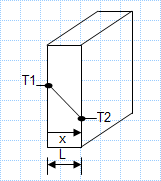Heat loss through single pane of glass.xls

Description
KNOWN: Temperature and convection coefficients associated with air at the inner and outer surfaces of a rear window.
FIND: a) Inner and outer window surface temperatures, Ts,i and Ts,? and T?,I and T?,o as a function of the outside air temperature T?,o and for selected values of outer convection coefficient.
ASSUMPTIONS: 1) Steady-state conditions.
2) One-dimensional conduction.
3) Negligible radiation effects.
4) Constant properties.
Calculation Reference
Fundamentals of Heat and Mass Transfer - Frank P. Incropera
To determine the inner and outer window surface temperatures (Ts,i and Ts,∞) as well as the outside air temperature (T∞,I and T∞,o) as a function of the outside air temperature (T∞,o) and for selected values of the outer convection coefficient, we can use the equations based on the assumption of one-dimensional conduction and steady-state conditions. Here's how you can approach the analysis:
-
Identify the known values: Note the values of the outside air temperature (T∞,o) and the convection coefficients associated with the inner and outer surfaces of the rear window.
-
Apply the convection equation: Use the equation for convective heat transfer to relate the temperature difference (ΔT) between the surface and the surrounding air to the convection coefficient (h) and the heat transfer rate (Q):
Q = h * A * ΔT
Where Q is the heat transfer rate (in watts), h is the convection coefficient (in watts per square meter-kelvin), A is the surface area of the window (in square meters), and ΔT is the temperature difference between the surface and the surrounding air (in kelvin).
-
Apply the energy balance equation: Apply the energy balance equation for each surface of the window, considering the heat transfer through conduction and convection:
For the inner surface: Q_in = k * A * (Ts,i - T∞,I)
For the outer surface: Q_out = k * A * (Ts,∞ - T∞,o)
Where Q_in and Q_out are the heat transfer rates through the inner and outer surfaces (in watts), k is the thermal conductivity of the window material (in watts per meter-kelvin), A is the surface area of the window (in square meters), Ts,i and Ts,∞ are the inner and outer surface temperatures (in kelvin), and T∞,I and T∞,o are the temperatures of the surrounding air (in kelvin).
-
Equate the heat transfer rates: Since the heat transfer rates through the inner and outer surfaces are equal (Q_in = Q_out), we can equate the expressions from step 3:
k * A * (Ts,i - T∞,I) = k * A * (Ts,∞ - T∞,o)
-
Solve for the surface temperatures: Rearrange the equation to solve for Ts,i and Ts,∞:
Ts,i = T∞,I + (Ts,∞ - T∞,o)
Ts,∞ = T∞,o + (Ts,i - T∞,I)
Substitute the known values of T∞,o, T∞,I, and solve for Ts,i and Ts,∞.
By following these steps, you can determine the inner and outer surface temperatures of the rear window as well as the outside air temperature as a function of the selected outside air temperature and the given convection coefficients.
Calculation Preview
Full download access to any calculation is available to users with a paid or awarded subscription (XLC Pro).
Subscriptions are free to contributors to the site, alternatively they can be purchased.
Click here for information on subscriptions.

